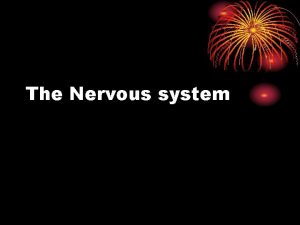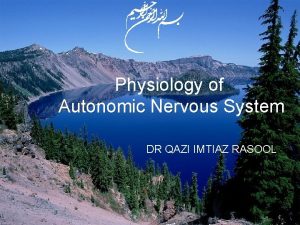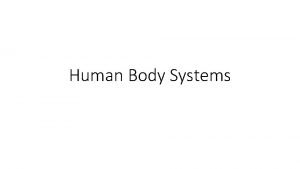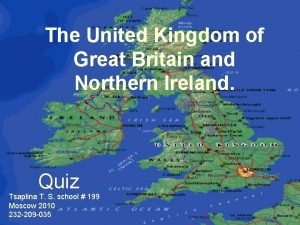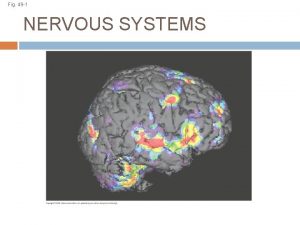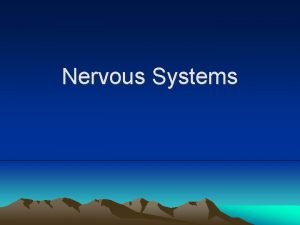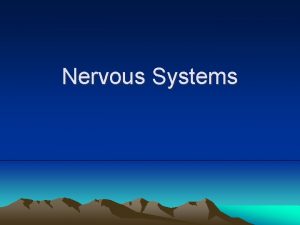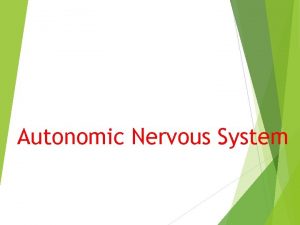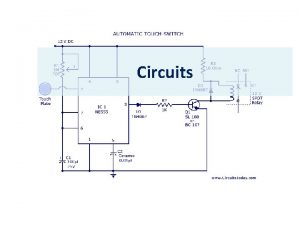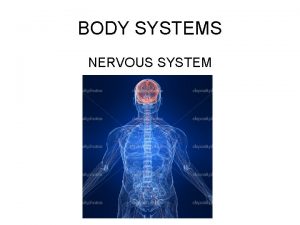Concept 49 1 NERVOUS SYSTEMS CONSIST OF CIRCUITS














- Slides: 14

Concept 49. 1 NERVOUS SYSTEMS CONSIST OF CIRCUITS OR NEURONS AND SUPPORTING CELLS Mary Kathryn Pearson, Susan Sabatier, and Olivia Johnson

SIMPLE NERVOUS SYSTEMS In most animals with nervous systems, clusters of neurons perform specialized functions. Such clustering is absent in the cnidarians, the simplest animals with nervous systems. In cnidarians, a series of interconnected nerve cells form a diffuse nerve net that controls the contraction and expansion of the gastrovascular cavity.

NERVOUS SYSTEM ORGANIZATION In more complex animals, the axons of multiple nerve cells may be bundled to form nerves which channel and organize information that flows along specific routes through the nervous system Animals with elongated, bilaterally symmetrical bodies have more specialized nervous systems. Example- Sea stars have a set of radial nerves connecting to a central nerve ring. Within each arm, the radial nerve is linked to a nerve net from which it receives input and to which it sends signals controlling motor activity. Such animals exhibit cephalization, the clustering of sensory neurons and interneurons at the anterior end. One or more nerve cords extending toward the posterior end connect these structures with nerves elsewhere in the body. In nonsegmented worms like the planarian, a small brain and longitudinal nerve cords make up the simplest clearly defined central nervous system (CNS).

NERVOUS SYSTEM ORGANIZATION CONT. In more complex invertebrates, such as annelids and arthropods, the number of neurons is much greater. Behavior is regulated by more complicated brains and by ventral nerve cords containing ganglia, segmentally arranged clusters of neurons. Within an animal group, nervous system organization often correlates with lifestyle. Sessile and slow-moving molluscs have relatively simple sense organs and little or no cephalization. Active predatory molluscs have the most sophisticated nervous systems of any invertebrate. In vertebrates, the brain and the spinal cord form the CNS; the nerves and ganglia make up the peripheral nervous system (PNS).

Eyespot Brain Radial nerve Nerve cords Nerve ring Transverse nerve Nerve net Brain Ventral nerve cord Segmental ganglia (a) Hydra (cnidarian) (b) Sea star (echinoderm) (c) Planarian (flatworm) (d) Leech (annelid) Brain Ventral nerve cord Anterior nerve ring Ganglia Brain Longitudinal nerve cords Ganglia (f) Chiton (mollusc) (g) Squid (mollusc) Spinal cord (dorsal nerve cord) Sensory ganglia Segmental ganglia (e) Insect (arthropod) (h) Salamander (vertebrate)

ORGANIZATION OF THE VERTEBRATE Brain and spinal cord of the vertebrate CNS are tightly coordinated Brain provides the integrative power that underlies the complex behavior of vertebrates Spinal cord conveys information to and from the brain and generates basic patterns of locomotion Acts independently of the brain as a part of the simple nerve circuits that produce reflexes

REFLEXES Protects the body by triggering a rapid, involuntary response to a particular stimulus Ex- touching a hot burner, picking up a heavy object Quadriceps muscle Cell body of sensory neuron in dorsal root ganglion Gray matter White matter Hamstring muscle Spinal cord (cross section) Sensory neuron Motor neuron Interneuron

SPINAL CORD Located on the dorsal side of the body Does not contain segmental ganglia but there is ganglia present just outside the spinal cord Central nervous system (CNS) Peripheral nervous system (PNS) Brain Cranial nerves Spinal cord Ganglia outside CNS Spinal nerves

SPINAL CORD CONT. Brain and spinal cord of vertabrates are derived from the dorsal embryonic nerve cord which is hollow In development, the hollow cavity is transformed into the narrow central canal of spinal cord and ventricles of the brain Both are filled with cerebrospinal fluid Formed by filtration of arterial blood in brain This fluid circulates slowly through central canal and ventricles then drains into the veins Supplies brain with nutrients and hormones Carries away wastes Cushions the brain and spinal cord by circulating between layers of connective tissue that surround the CNS

GRAY MATTER AND WHITE MATTER Gray matter- consists of neuron cell bodies, dendrites, and unmyelinated axons White matter- bundled axons that have myelin sheaths Gives the axons a whitish appearance White matter in spinal cord on the outside Links the CNS to sensory and motor neurons of the PNS

WHITE MATTER IN BRAIN On the inside Reflecting the role of signaling between neurons of the brain in learning, feeling emotions, processing sensory information, and generating commands Gray matter White matter Ventricles

PERIPHERAL NERVOUS SYSTEM Afferent neurons: sensory neurons Efferent neurons Motor system Autonomic nervous system

EFFERENT NEURONS Motor system (locomotion): controls skeletal muscles (mainly in response to external stimuli) Autonomic nervous system: controls smooth and cardiac muscles ad the organs of the digestive, cardiovascular, excretory and endocrine systems. Sympathetic division Parasympathetic division Enteric division

EFFERENT NEURONS (CONT’D) Autonomic Nervous System: Sympathetic division Corresponds to arousal and energy generation (“fight-or -flight” response) Ex. Gas exchange Parasympathetic division Causes opposite responses that promote calming and a return to self-maintenance functions Ex. Circulation Enteric division Controls secretion and the smooth muscle in the digestive tract, pancreas and gallbladder Ex. Digestion
 Neuronal pools
Neuronal pools Sensory input and motor output
Sensory input and motor output Processes neuron
Processes neuron Current in a parallel circuit
Current in a parallel circuit Concept map of the brain
Concept map of the brain Chapter 14 skeletal muscular and nervous systems
Chapter 14 skeletal muscular and nervous systems Sympathetic nervous system
Sympathetic nervous system Prevertebral ganglia
Prevertebral ganglia Major divisions of nervous system
Major divisions of nervous system Nervous interactions with other systems
Nervous interactions with other systems 2057 octal to decimal
2057 octal to decimal Binary systems and logic circuits
Binary systems and logic circuits Transactions on circuits and systems
Transactions on circuits and systems Great britain countries
Great britain countries Great britain consist of
Great britain consist of




